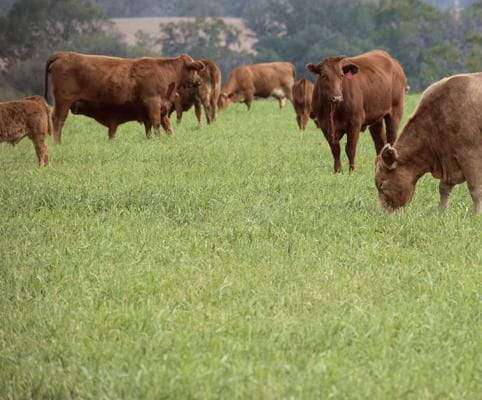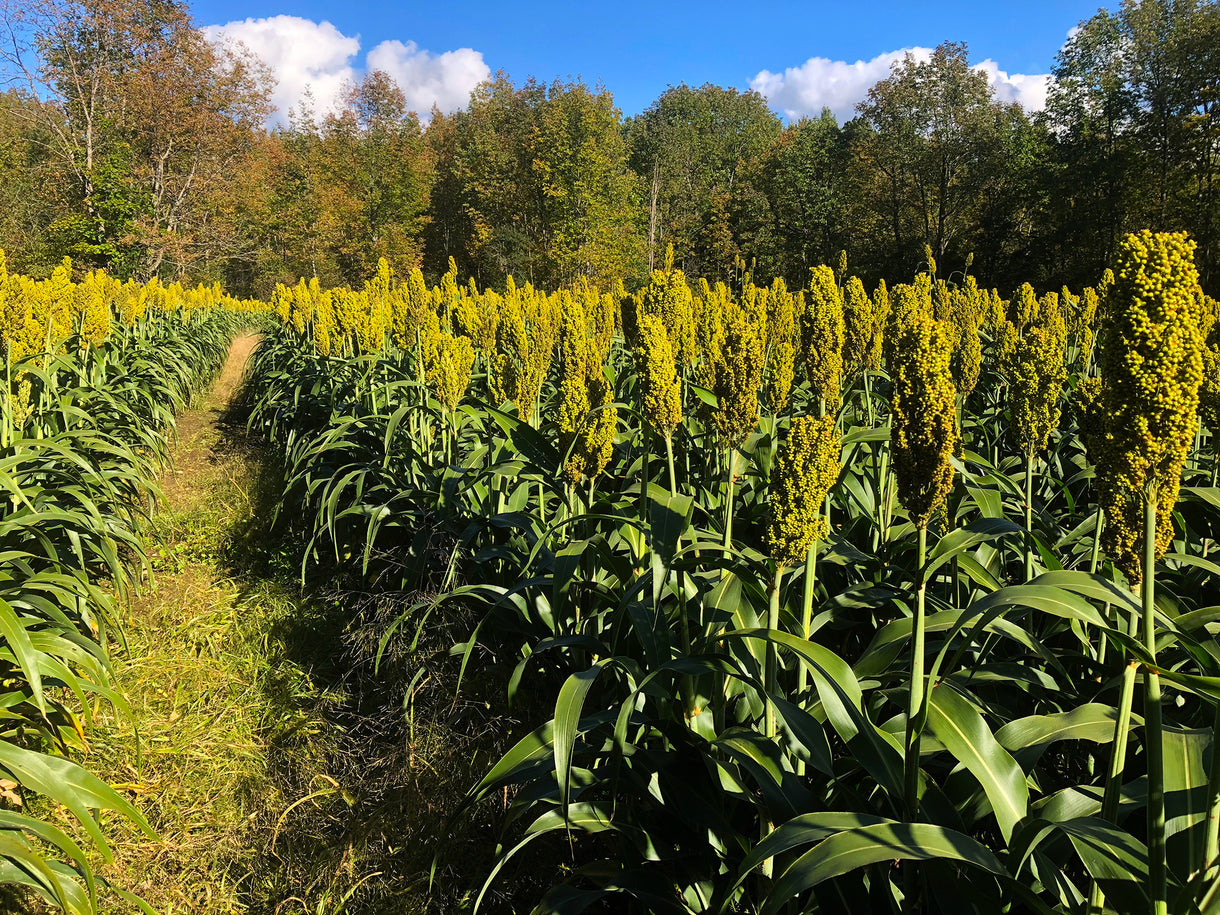Popular Products
Popular Products

- When to plant:
- Spring, Summer
- Fertilizer:
- 10-10-10 All Purpose Fertilizer
- Seeding rate:
- 25 - 30 lbs per acre
- Overseeding rate:
- 20 lbs per acre
- Seeding depth:
- 1/4 - 1/2 inch
- Ideal ph:
- 5.5 - 7.0
- Gmo:
- No
- Inoculant needed:
- No
- Coated or raw:
- Raw
- Lifecycle:
- Annual
- Climate zones:
- Cool Season, Transition Zone, Warm Season
Japanese Millet is popularly known as "Billion-Dollar Grass," and those aiming to attract duck to their property believe it's worth every cent! This variety of millet is able to handle standing water as long as the seedling does not become totally submerged.
Product Information
- Application or Use: Cover Crop, Erosion Control, Cattle Forage, Livestock Grazing, Food Plot
- Germination Time: 5 - 7 days, under optimal conditions
- Growing Locations: Warm Season, Transition Zone, Cool Season
- Height: 3 - 5 feet
- Sunlight Requirements: 8+ hours, full sun for best results
- Advantages: Very tolerant to wet conditions; strong nurse crop to protect slower growing legumes.
- When to Plant: Recommended planting time is spring and summer when night time temperatures are consistently 65+ degrees.
Product Details
- Non-GMO
- Able to handle standing water
- Commonly used for feeding ducks
- Great for erosion control
- Quick growing companion crop with perennial grasses and legumes
Product Information
Japanese Millet Seed is commonly used for feeding ducks, as this millet will grow in flooded soils or standing water. Japanese millet is a tall, medium stalked millet that has a 65-90 day life span. Japanese millet is great for dove fields, duck ponds, deer feed, pheasant feed, cover crops, bird seed, erosion control and much more.
Japanese millet is an exceptional wildlife plant. It is a choice duck food, and is eaten by 17 species of northeastern waterfowl. This food is also used by five upland game birds and many non-game birds, such as sparrows, finches, and cardinals. Leaves and seed-heads are eaten by rabbits and muskrats. As an erosion control plant it is used as a quick growing companion crop with perennial grasses and legumes and is especially suited to wet sites.
Japanese Millet, more commonly referred to as "billion-dollar grass," is an introduced annual. It has coarse leaves and varies from 1 to 5 ft. in height, depending on available moisture and fertility. The seed-head is a compact panicle-type inflorescence four to eight in. long, purplish in color, with awnless seeds. Billion-dollar grass produces a much heavier seed yield than the wild species. There are approximately 155,000 seeds per lb.
Japanese millet is well suited for areas with wet conditions. With a tolerance for wet and muddy soil conditions while growing, japanese millet is able to be flooded while growing as long as its leaves remain above water. After maturity is reached, a japanese millet plot is able to be flooded and used as a duck pond due to its tolerance for wetness. This tolerance for wetter conditions also makes japanese millet a strong nurse crop to protect slower growing, more tender legumes.
Japanese Millet was previously a major source of sustenance in Japan, Korea, China, and India, and remains a smaller crop in those regions to this day. It has slowly lost popularity for food purposes as better varieties of rice have been cultivated to withstand colder temperatures, which was previously Japanese Millet's main claim to fame. Still, the crop remains popular as a source of food for all varieties of birds!
Japanese Millet Seed is Non-GMO
*Product packaging may appear different than what is pictured.
Japanese millet duck food plots should be planted before the rainy season allowing the plant to sprout and begin growing before the standing water comes in. This millet can handle standing water if the young plant doesn't become completely submerged. Japanese millet is most successful when planted on prepared soil, although japanese millet will germinate and grow just about anywhere. For duck food plots, plant the japanese millet early in the summer (June-July) depending on the start date of your duck season. Japanese millet seed heads will hold on longer than most millet varieties, even in standing water. The seed will slowly drop out of the seed head feeding the ducks over time.
Japanese millet planted for dove fields should be planted at 5 to 10 lbs. per acre spacing out the plants. By spacing the plants out it will allow the birds to locate the seed much easier after the plants are mowed or harvested. Planting japanese millet too thick will decrease the plants seed production and create an abundance of plant material preventing the birds from locating the seed after mowing and harvesting. It may seem like a small amount for a entire acre but 5 lbs. planted properly will completely cover the soil and provide plenty of seed for your birds.
Seed may be drilled or broadcast and incorporated to a one inch depth on upland sites. In wetland areas, draw down water levels and broadcast seed on top of wet ground. Seeding rate for pure stands is 20 lbs./acre when drilled and 25-30 lbs./acre if broadcast. In a mixture reduce rate to 8-12 lbs./acre. Planting is recommended after the last killing frost in the spring. The seeding date may be timed to synchronize the maturity date of seed with the fall migration of specific migratory birds.
As an upland food source, japanese millet should be planted in pure stands as a field crop. For waterfowl, wetland areas planted in the spring should not be reflooded until the plants are at least six inches tall. During the migratory season, it is best to wait to flood until the crop is 12-18 in. Japanese Millet should be replanted annually to ensure a healthy growth.
When choosing to start a new lawn, remove old vegetation by using a de-thatcher, power rake or tiller to kill the existing vegetation. Rake or drag the area to remove debris and dead grass for a clean area. Ensure the soil is leveled and loosened to allow the seed to have good soil contact once spread on a clean seed bed.
If you have an area with heavy weed coverage, we recommend starting fresh by killing and removing the existing vegetation. If you choose to use chemicals, herbicides or fertilizers, you must check with the product's manufacturer prior to planting new seed to ensure the proper waiting period.
When overseeding an existing area, mow your lawn at the lowest setting and bag the clippingsx. Rake or drag any areas that have dead thatch or debris.

Seed Quality
Hancock Seed is dedicated to delivering the best seeds possible to our customers. Hancock Seed grows and harvests many of our products, and we acquire the majority of the rest from other family farmers.
All these seeds are processed, packaged and shipped from Hancock Farm. This helps us ensure that our high standards are met. Unlike much of the competition, we refuse to sell you a seed that was not gathered during the last harvest. You will always receive fresh product from Hancock.
Every seed we grow comes with 40 years of experience behind it...you can rest assured that all of our products are cultivated in a method that assures its potential for growth.

Your cart ( 0 )

Japanese Millet is popularly known as "Billion-Dollar Grass," and those aiming to attract duck to their property believe it's worth every cent! This variety of millet is able to handle standing water as long as the seedling does not become totally submerged.
Product Information
- Application or Use: Cover Crop, Erosion Control, Cattle Forage, Livestock Grazing, Food Plot
- Germination Time: 5 - 7 days, under optimal conditions
- Growing Locations: Warm Season, Transition Zone, Cool Season
- Height: 3 - 5 feet
- Sunlight Requirements: 8+ hours, full sun for best results
- Advantages: Very tolerant to wet conditions; strong nurse crop to protect slower growing legumes.
- When to Plant: Recommended planting time is spring and summer when night time temperatures are consistently 65+ degrees.
Product Details
- Non-GMO
- Able to handle standing water
- Commonly used for feeding ducks
- Great for erosion control
- Quick growing companion crop with perennial grasses and legumes
Product Information
Japanese Millet Seed is commonly used for feeding ducks, as this millet will grow in flooded soils or standing water. Japanese millet is a tall, medium stalked millet that has a 65-90 day life span. Japanese millet is great for dove fields, duck ponds, deer feed, pheasant feed, cover crops, bird seed, erosion control and much more.
Japanese millet is an exceptional wildlife plant. It is a choice duck food, and is eaten by 17 species of northeastern waterfowl. This food is also used by five upland game birds and many non-game birds, such as sparrows, finches, and cardinals. Leaves and seed-heads are eaten by rabbits and muskrats. As an erosion control plant it is used as a quick growing companion crop with perennial grasses and legumes and is especially suited to wet sites.
Japanese Millet, more commonly referred to as "billion-dollar grass," is an introduced annual. It has coarse leaves and varies from 1 to 5 ft. in height, depending on available moisture and fertility. The seed-head is a compact panicle-type inflorescence four to eight in. long, purplish in color, with awnless seeds. Billion-dollar grass produces a much heavier seed yield than the wild species. There are approximately 155,000 seeds per lb.
Japanese millet is well suited for areas with wet conditions. With a tolerance for wet and muddy soil conditions while growing, japanese millet is able to be flooded while growing as long as its leaves remain above water. After maturity is reached, a japanese millet plot is able to be flooded and used as a duck pond due to its tolerance for wetness. This tolerance for wetter conditions also makes japanese millet a strong nurse crop to protect slower growing, more tender legumes.
Japanese Millet was previously a major source of sustenance in Japan, Korea, China, and India, and remains a smaller crop in those regions to this day. It has slowly lost popularity for food purposes as better varieties of rice have been cultivated to withstand colder temperatures, which was previously Japanese Millet's main claim to fame. Still, the crop remains popular as a source of food for all varieties of birds!
Japanese Millet Seed is Non-GMO
*Product packaging may appear different than what is pictured.
Japanese millet duck food plots should be planted before the rainy season allowing the plant to sprout and begin growing before the standing water comes in. This millet can handle standing water if the young plant doesn't become completely submerged. Japanese millet is most successful when planted on prepared soil, although japanese millet will germinate and grow just about anywhere. For duck food plots, plant the japanese millet early in the summer (June-July) depending on the start date of your duck season. Japanese millet seed heads will hold on longer than most millet varieties, even in standing water. The seed will slowly drop out of the seed head feeding the ducks over time.
Japanese millet planted for dove fields should be planted at 5 to 10 lbs. per acre spacing out the plants. By spacing the plants out it will allow the birds to locate the seed much easier after the plants are mowed or harvested. Planting japanese millet too thick will decrease the plants seed production and create an abundance of plant material preventing the birds from locating the seed after mowing and harvesting. It may seem like a small amount for a entire acre but 5 lbs. planted properly will completely cover the soil and provide plenty of seed for your birds.
Seed may be drilled or broadcast and incorporated to a one inch depth on upland sites. In wetland areas, draw down water levels and broadcast seed on top of wet ground. Seeding rate for pure stands is 20 lbs./acre when drilled and 25-30 lbs./acre if broadcast. In a mixture reduce rate to 8-12 lbs./acre. Planting is recommended after the last killing frost in the spring. The seeding date may be timed to synchronize the maturity date of seed with the fall migration of specific migratory birds.
As an upland food source, japanese millet should be planted in pure stands as a field crop. For waterfowl, wetland areas planted in the spring should not be reflooded until the plants are at least six inches tall. During the migratory season, it is best to wait to flood until the crop is 12-18 in. Japanese Millet should be replanted annually to ensure a healthy growth.
Instructions
When choosing to start a new lawn, remove old vegetation by using a de-thatcher, power rake or tiller to kill the existing vegetation. Rake or drag the area to remove debris and dead grass for a clean area. Ensure the soil is leveled and loosened to allow the seed to have good soil contact once spread on a clean seed bed.
If you have an area with heavy weed coverage, we recommend starting fresh by killing and removing the existing vegetation. If you choose to use chemicals, herbicides or fertilizers, you must check with the product's manufacturer prior to planting new seed to ensure the proper waiting period.
When overseeding an existing area, mow your lawn at the lowest setting and bag the clippingsx. Rake or drag any areas that have dead thatch or debris.




















